Safer K-12 Design: School Should Feel – and Look – Like School
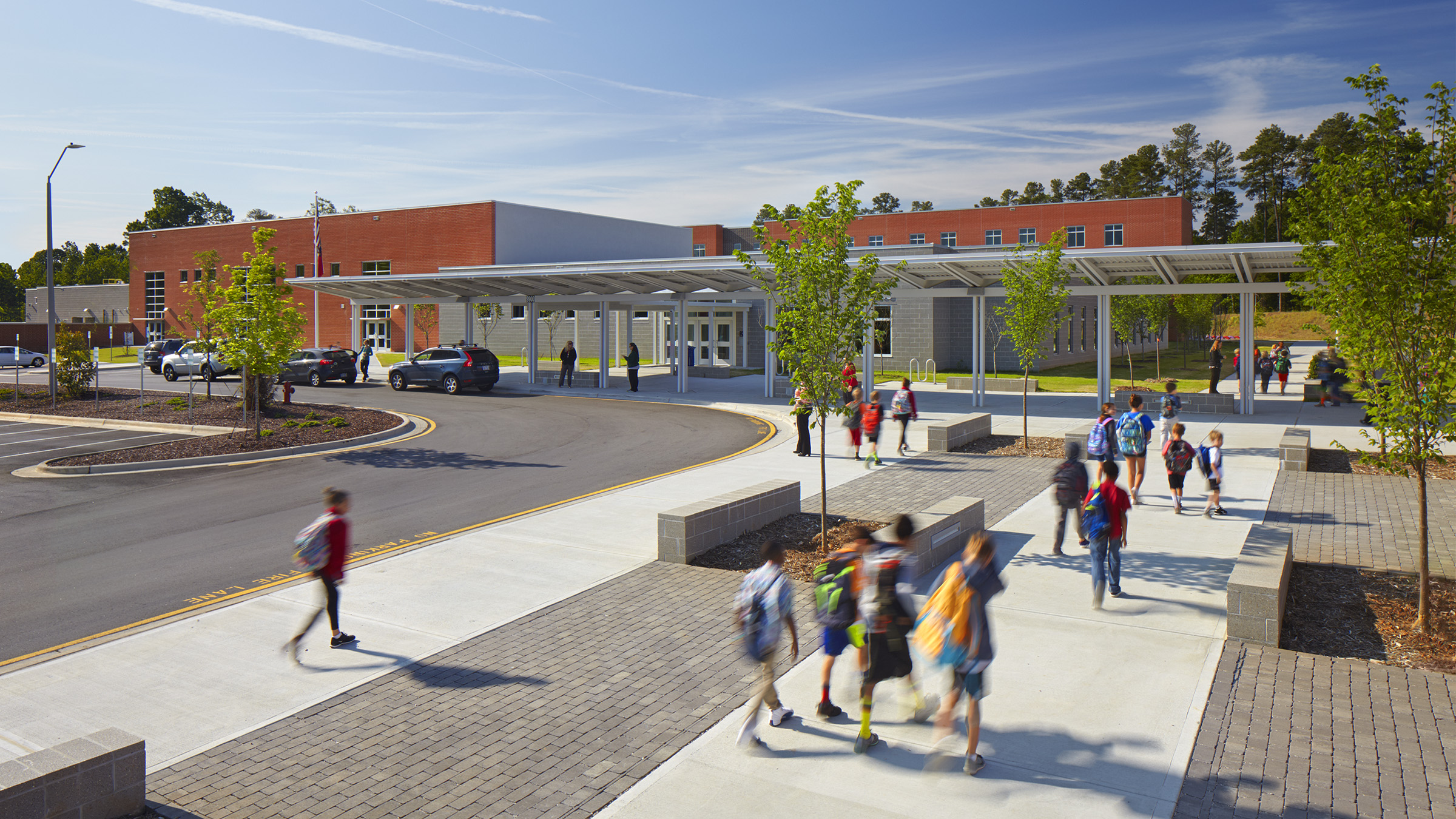 In an age during which stories of bullying, school shootings, and mental health concerns are all too common, designers have a critical role to play in crafting K-12 schools that simultaneously promote engaged learning and student safety.
In an age during which stories of bullying, school shootings, and mental health concerns are all too common, designers have a critical role to play in crafting K-12 schools that simultaneously promote engaged learning and student safety.
At the crux of this conversation is the need to ensure that school design stays centered on “school” – meaning we create environments that inspire and empower learning. In the following, Clark Nexsen’s Becky Brady discusses K-12 design philosophy and reviews specific design elements that support safety in our schools:
w
K-12 schools exist to engage students in active learning, providing them with the skills and knowledge for successful futures. Unquestionably, these environments should also be safe and welcoming. Today’s students grapple with concerns including bullying, fights, the risk of school shootings, natural disasters, and mental health of students and teachers, which means that my job as a designer is to find innovative ways to make the learning space open and inclusive while also secure.
Designers can work to achieve this balance by considering a number of “invisible hardening” tactics, which go unnoticed by the general public, in addition to rethinking spaces to naturally minimize threats to student safety:
Streamline Entrances
A critical design element in school safety is addressing the building entry. By funneling visitors to a single point of entry and creating a vestibule within that entry where they can be greeted and identified, the school can better control access and safety.
Crime Prevention through Environmental Designs (CPTED), whose goal is to design a physical environment that positively influences human behavior, stresses the importance of natural surveillance to maximize visibility. This means that the single point of entry and other key monitoring areas should have visual to specific outdoor areas including the parent drop off zone, the bus loop, parking, and waiting zones. This visual enables school staff to rapidly identify any behavior that is unusual and potentially dangerous.
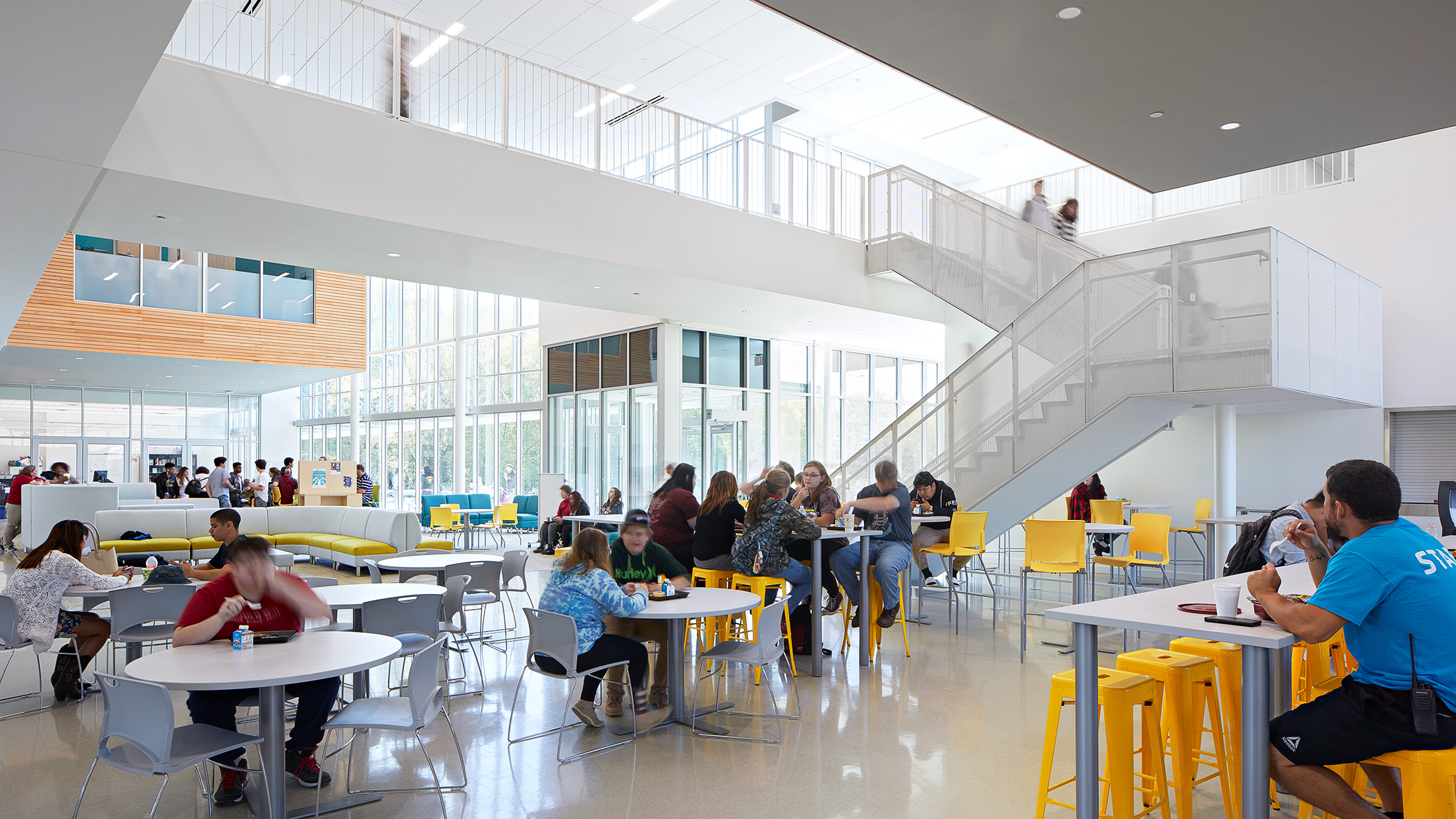
At Hendersonville’s Innovative High School, students integrate into a community college environment. The highly transparent space enables staff to easily track entry and student interaction in the large commons area.
Access management is another environmental design component stressed by CPTED. Loading docks and service yards should be located away from the main entry with their own specific entries, enabling service and deliveries to take place smoothly and safely. Additionally, ensuring operable windows are closed and locked is a simple way to avoid inappropriate entry.
Recently, Clark Nexsen’s K-12 practice worked on a high school project to evaluate renovating the existing five-building facility or replacing it with a new school. A major factor in the decision to develop a new high school was the identification of 59 different entries and exits between the existing buildings – making it impossible to effectively monitor building access. The new design features three main student entries, all controlled – an appropriate number for the 2,200 student body. These entries are visually monitored at all times and are accessible by card reader only at off-hours, and a single visitor point of entry allows maximum control by office staff.
Open Design Establishes Clear Sight Lines
Bullying is by far the most prevalent safety concern in schools, and the majority of bullying happens not in classrooms, but in corridors or enclosed places where teacher supervision is a challenge. By providing clear sight lines and eliminating areas that could become hiding places, teachers and staff can easily observe students and recognize if something is out of the ordinary. This early and rapid identification of potential conflicts enables them to be dealt with more effectively. Equally significant, a person is much less likely to commit a crime if they think someone may see them do it – and this applies to bullying between students as well.
Achieving an open design is the result of developing a simple overall building layout. Limiting the number of corridors, corners, and necessary points of visual surveillance enables teachers and staff to more easily supervise students’ movement throughout the school.
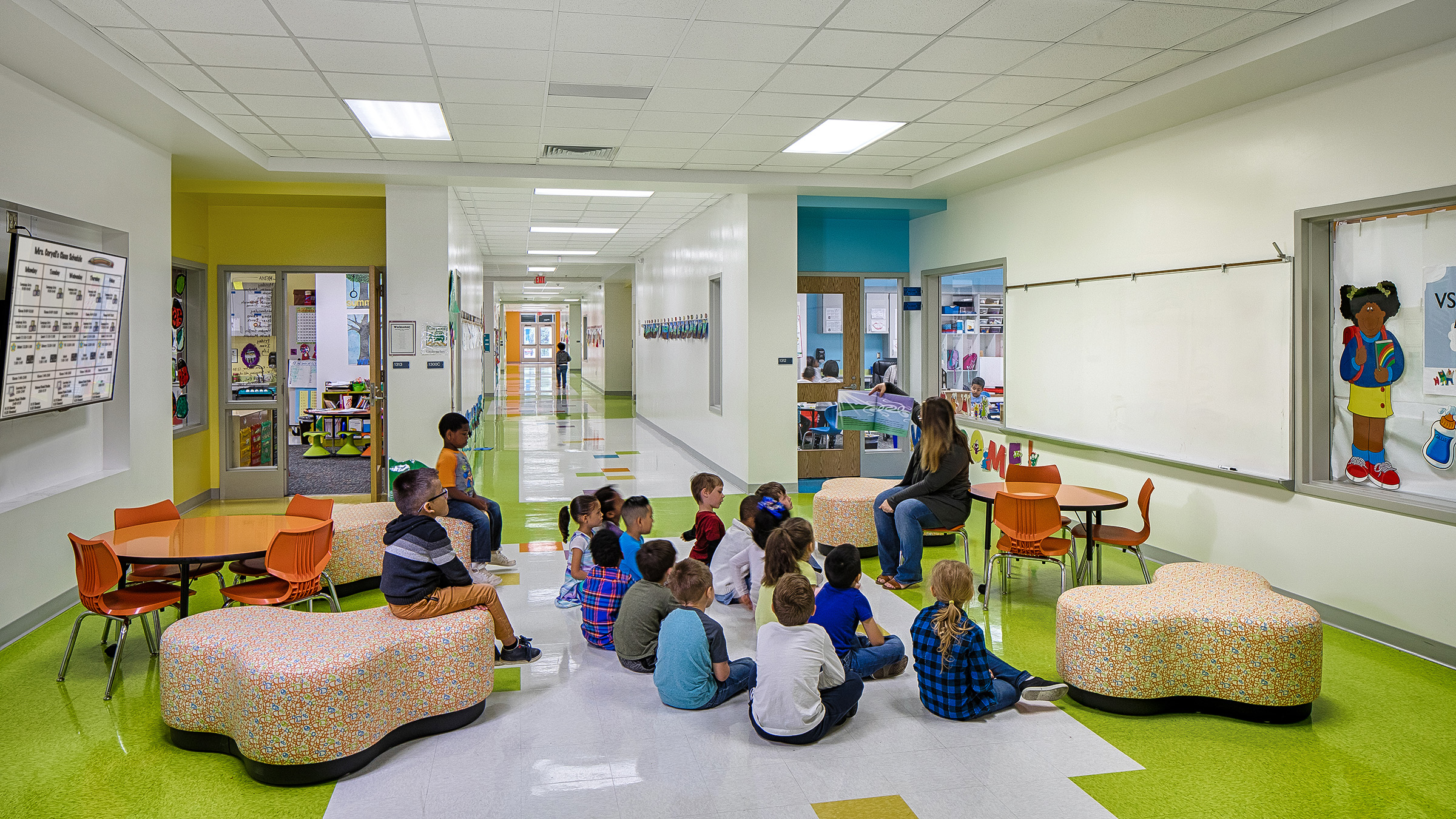
Open design is achieved in a number of ways – by eliminating extraneous corridors and possible hiding places; providing daylight to each classroom or learning space through interior and exterior windows; and by orienting school layouts to have multi-faceted visibility points. These sight lines can be vital to student safety by facilitating adult supervision from space to space.
Wider Corridors & Stairs Minimize Conflict
The creation of wider corridors and stairs offers students a maximum amount of space to circulate, in turn reducing the likelihood of conflict. For example, one student brushing up against another while passing by could be avoided if enough space is provided – and while that infraction may seem minimal, it can be all that’s needed to precipitate a conflict.
While the International Building Code dictates a six foot wide minimum corridor in educational facilities, the book Building Security: A Handbook for Architectural Planning and Design, by Barbara Nadel, FAIA, recommends a 10 to 12 foot wide corridor to promote student safety. Further, it outlines that the main entry should not be less than 20 feet wide. Additional considerations to minimize conflict during class changes and student circulation include allowing natural light into circulation spaces to make them feel larger and more inviting and carefully coordinating structural columns so as not to impede on the width of the hallway.
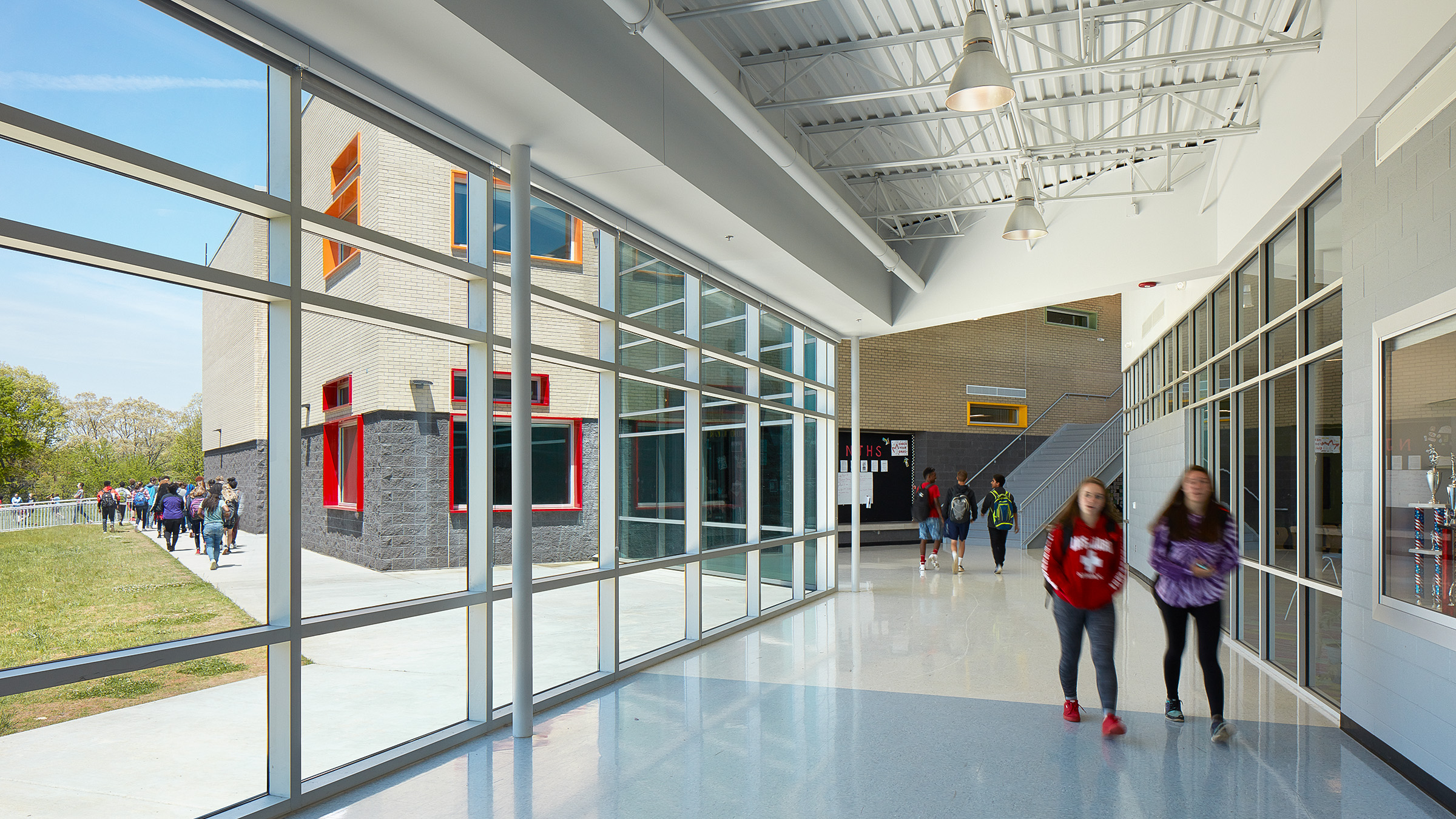
At Asheville Middle School, abundant natural light and accommodating circulation support a safe environment for students during the transitional and often challenging middle school years.
Create Neutral Learning Commons
Learning commons or “collaboration spaces” are a key element in 21st Century Learning — a project-based learning style, focusing on critical thinking and problem solving, communication, collaboration, and creativity in innovation. In addition to being a place for groups of students to work together, the learning commons acts as an area for students to go that is comfortable, safe, supervised, and relaxed. It is inherently different from a classroom with softer furniture and can be thought of as the living room of the school. The value of this space in the school safety discussion is its role as a place for students to cool down if tensions get high and to provide a space to relax at school in a way that not all students may be able to at home.
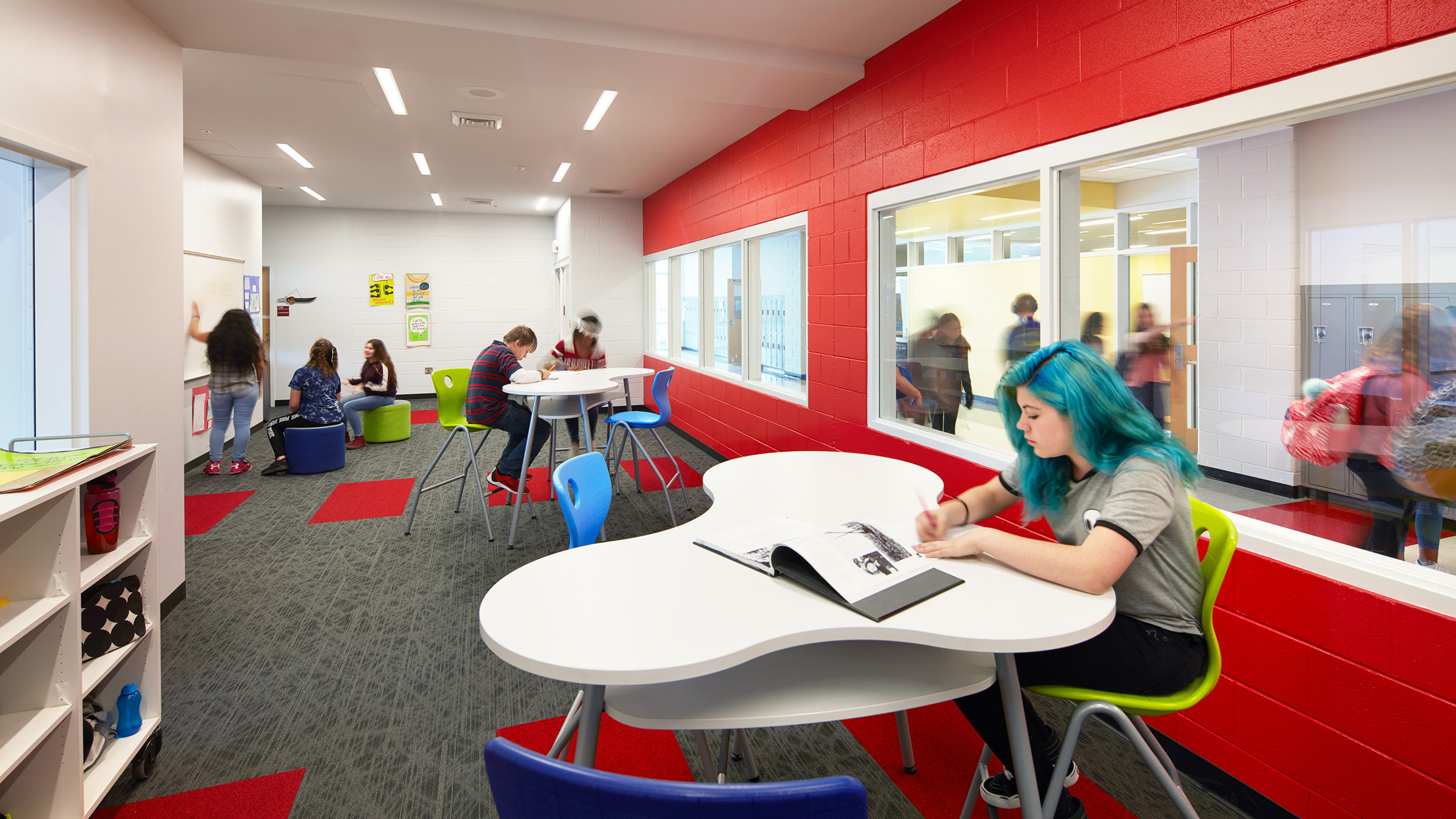
With transparency to the corridor and adjacent classroom, this middle school learning commons offers students a balance between supervision and independence. Teachers and staff can ensure student safety while project-based, collaborative learning takes place.
Make Schools Community-Centric
In a world where schools are growing larger due to economies of scale, it is critically important to foster small communities within the larger school community. Inherently, there is a greater possibility of a security issue arising in a larger school, so the creation of smaller communities provides layers of belonging and stronger interpersonal relationships among students.
In the aforementioned book, Building Security, Nadel also discusses the differences in large schools and small schools, noting:
“When communities are smaller, interaction improves, students become familiar and take responsibility for each other, the learning atmosphere is enhanced, and security is better.”
Within large schools, smaller communities may be defined by clubs or activities, classrooms, and grade level separation. Establishing designated areas for individual communities to gather can help foster these groups and support each student’s needs.
Beyond the school walls, these facilities are recognizable in any community, often nestled within a neighborhood. If neighbors, surrounding businesses, and passersby all take pride and ownership in the school, it will benefit from continuous monitoring. Integrating community spaces and feedback is central to designing schools that are viewed as the heart of a community.
Connect to the Outdoors
Extensive research indicates the value of connectivity with the outdoors as beneficial to mental health. Schools with natural daylighting, views, and outdoor space demonstrate higher student engagement and test scores, and fewer violent incidents.
The amount of time a student spends outdoors during the school day varies, but its significance is its role as a prevalent part of the day where the student generally feels ownership of “their time.” Outdoor spaces for education, varied play, or new experiences all enhance overall physical and mental health, in addition to benefitting emotional and behavioral skills. If outdoor time isn’t a possibility, exposure to nature still demonstrates compelling positive results. Daylighting, access to a window, and the inclusion of plants in the classroom can all play a role.
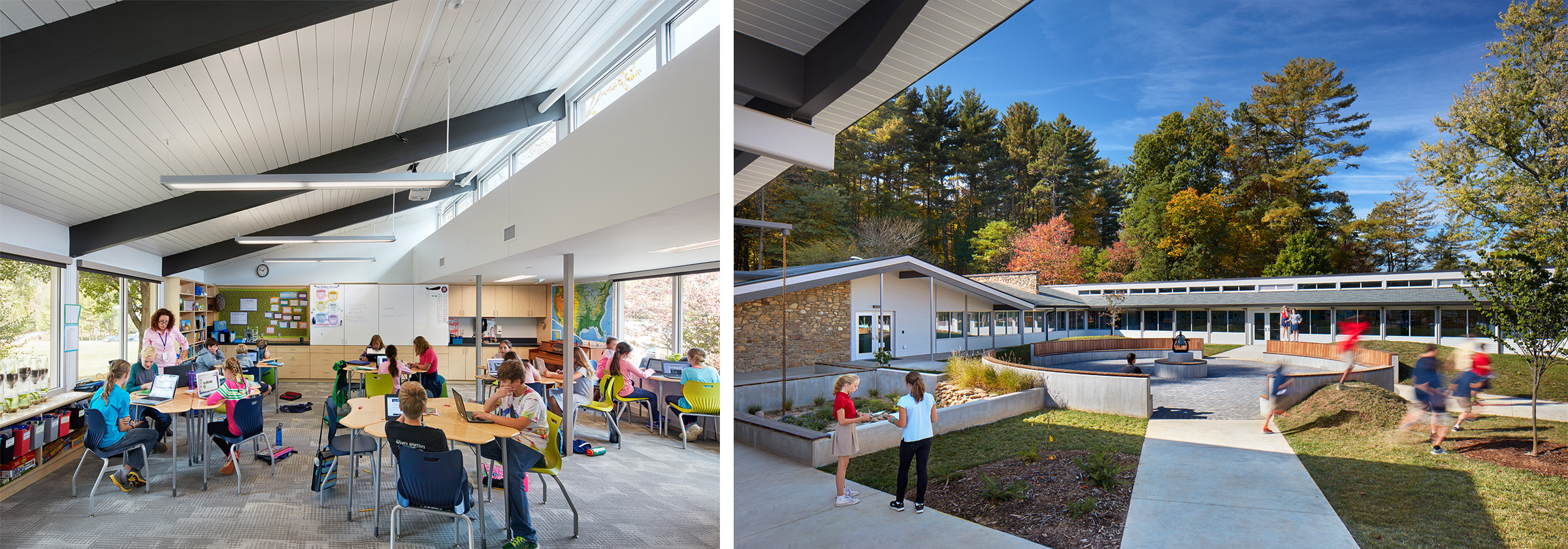
The renovation and addition to Carolina Day School emphasized indoor-outdoor connectivity. Large windows allow natural light into the classrooms and a newly-created courtyard serves as a popular outdoor classroom and play space.
Consider Site Design Carefully
The design of a school site sets the tone for the school building and provides an opportunity to address safety concerns related to the clear separation of vehicular, bus, and foot traffic, as well as access. Common site considerations include plantings, covered waiting areas, site lighting, fencing, and safe pathways for students who walk or bike to school.
While plantings and similar site elements help define the site and provide shading, these can also present a risk and be utilized as hiding places if visual monitoring is not considered during the design process. By integrating plantings judiciously and with visibility as the priority, they can be safely incorporated.
Depending on the situation and school setting, a continuous fence enclosing the entire school site is not always an appropriate design solution. Philosophically, Clark Nexsen’s K-12 practice believes this centers on the importance of the school being integral to the fabric of its community – a continuous fence, particularly opaque fencing, separates the school from its community and interferes with the community’s sense of responsibility and ownership for student safety. In some scenarios, a fence may indeed be the right solution, but it is one to consider carefully and in conjunction with other elements.
Visual monitoring is particularly important for playground and field areas. These considerations include proximity to the school building for younger children (sometimes within a fenced area), while playgrounds for older students may be located near sports or multipurpose fields.
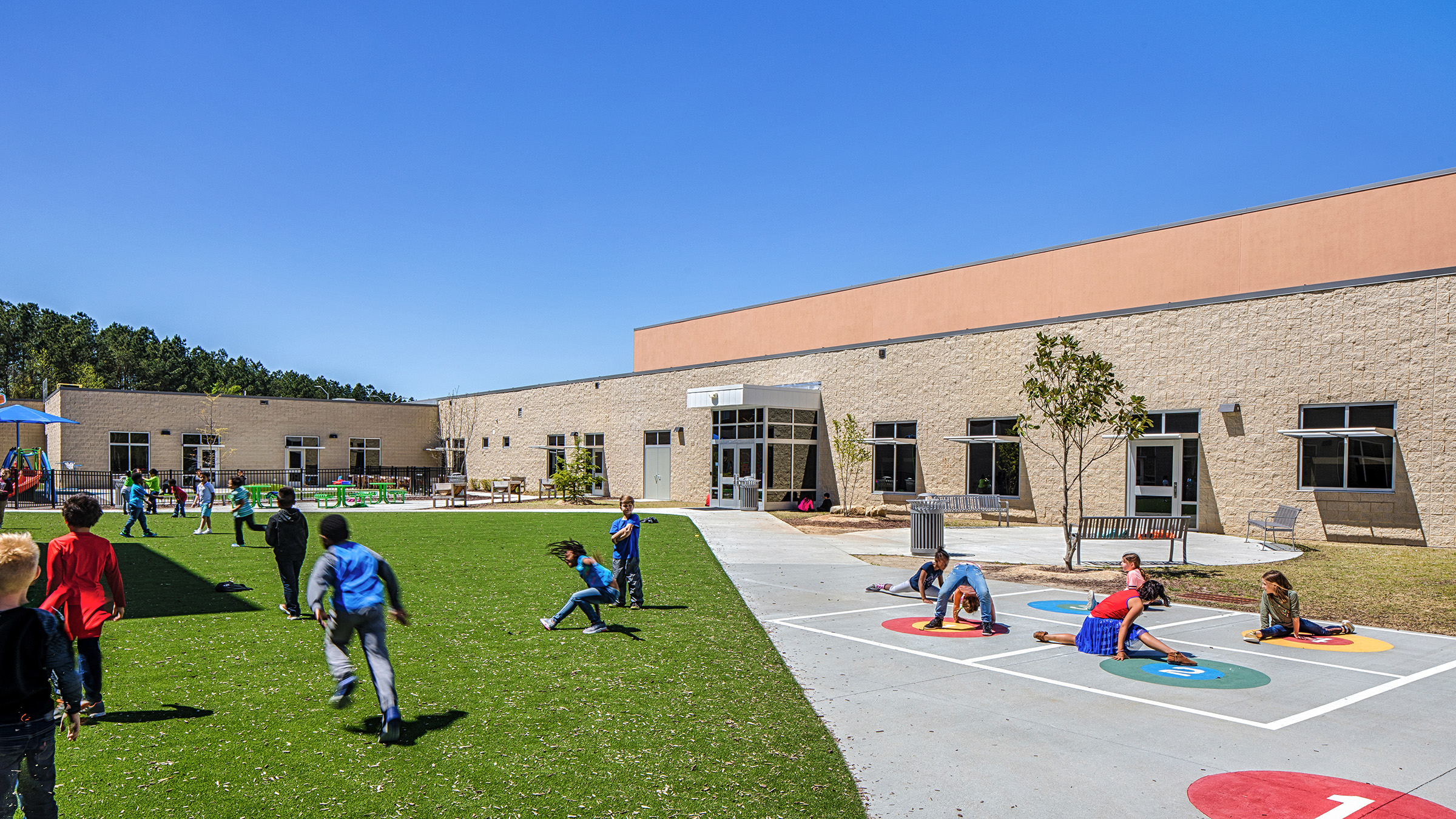
At Bryan Road Elementary, the courtyard houses the play areas for the Pre-K and K-2 students, while play areas for grades three through five are located at the adjacent to the playing field. The multipurpose field serves as a community resource, hosting town recreation programs as well as student activities.
Possibilities for enhancing safety without sacrificing a school’s sense of identity as a place for learning only continue to grow as technology advances. Beyond the design elements discussed above, these features include classroom doors that are lockable from the interior (to prevent intrusion), the use of drywall ceilings in private spaces like restrooms (to prevent contraband being hidden in the ceiling), and the addition of bullet resistant film on glazing. All of these components can be integrated seamlessly, without negatively impacting the student experience.
In Summary: School Should Feel – and Look – Like School
As discussed at a town hall meeting held by high school students in North Carolina, the message that a building sends to a student is as important as the building itself. The inclusion of elements such as bars on windows or metal detectors, and the elimination of windows and open spaces, sends a message of being closed off – not welcoming. They serve as a constant visual reminder that something may go wrong.
In a nutshell, school should feel like school. School is a place to engage, grow, learn to think critically, and understand complex concepts. A school climate should include learning spaces that meet the needs of various learning styles. The visual message of energetic welcome does not need to be lost in exchange for security – design methods exist to create safe and welcoming environments. In addition to design, technology, policies, procedures, adult-student interaction, and resources all play a role in school safety. There is no “one size fits all” solution, and being part of the evolving discussion and research regarding school design is key to ensuring our schools are both safe and welcoming learning environments.

Becky Brady, AIA, ALEP, CDT, LEED AP BD+C, is an architect specializing in K-12 and educational design. As a member of a national taskforce created by the Association for Learning Environments (A4LE), Becky is studying the many different aspects that impact school safety. To learn more about our K-12 practice or to discuss the impact of design on school safety in greater detail, please contact Becky at rbrady@clarknexsen.com or 919.828.1876.
x